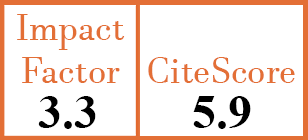Full Papers
Identification of a circRNA-miRNA-mRNA network to explore the effects of circRNAs on pathogenesis and treatment of systemic lupus erythematosus
Q. Wei1, J. He2, C. Wu3, P. Makota4, F. Gao5, H. Lin6, L. Cai7, Z. Chen8
- Department of Rheumatology, Fujian Provincial Hospital, Fuzhou, and Fujian Medical University Provincial Clinical Medical College, Fuzhou, China.
- Department of Rheumatology, Fujian Provincial Hospital, Fuzhou, and Fujian Medical University Provincial Clinical Medical College, Fuzhou, China.
- Department of Rheumatology, Fujian Provincial Hospital, Fuzhou, and Fujian Medical University Provincial Clinical Medical College, Fuzhou, China.
- Fujian Medical University Provincial Clinical Medical College, Fuzhou, China.
- Department of Rheumatology, Fujian Provincial Hospital, Fuzhou, and Fujian Medical University Provincial Clinical Medical College, Fuzhou, China.
- Department of Rheumatology, Fujian Provincial Hospital, Fuzhou, and Fujian Medical University Provincial Clinical Medical College, Fuzhou, China.
- Fujian Medical University Provincial Clinical Medical College, Fuzhou, China. cailiangchun@fjmu.edu.cn
- Department of Rheumatology, Fujian Provincial Hospital, Fuzhou, and Fujian Medical University Provincial Clinical Medical College, Fuzhou, China. zhihanchen213@163.com
CER15789
2023 Vol.41, N°5
PI 1068, PF 1076
Full Papers
PMID: 36226610 [PubMed]
Received: 19/04/2022
Accepted : 25/07/2022
In Press: 12/10/2022
Published: 03/05/2023
Abstract
OBJECTIVES:
Systemic lupus erythematosus (SLE) is an autoimmune disease characterised by immune inflammation. It involves multiple organs. Many studies have demonstrated that circRNAs are closely associated with SLE. Nonetheless, the potential mechanism by which circRNAs impacts SLE is not fully understood. The aim of this study was to explore the regulatory roles of circRNAs, the key genes and pathways governing the pathophysiological processes of SLE, and to screen therapeutic agents.
METHODS:
The sequencing data of circRNA, miRNA and mRNA were obtained from Gene Expression Omnibus (GEO) datasets. Candidates were identified to construct a circRNA-miRNA-mRNA network based on circRNA-miRNA interactions and miRNA-mRNA interactions. Gene functional enrichments were performed on the DAVID database. Protein-protein interaction (PPI) network was constructed by STRING database and visualised in Cytoscape software. The hub genes were explored by the MCODE plugin app. The Connectivity Map L1000 platform was used to identify potential agents.
RESULTS:
A total of 1093 differentially expressed circRNAs (DEcircRNAs), 42 differentially expressed miRNAs (DEmiRNAs) and 1431 differentially expressed mRNAs (DEmRNAs) were identified. We integrated 3 overlapped circRNAs, 13 miRNAs and 352 target mRNAs into a circRNA-miRNA-mRNA network. We next identified 44 hub genes based on the PPI network. KEGG pathway analysis revealed that the DEGs were mainly associated with MAPK signalling pathway. In addition, we discovered several chemicals as potential treatment options for SLE.
CONCLUSIONS:
Through this bioinformatics analysis, we suggest a regulatory role for circRNAs in the pathogenesis and treatment of SLE from the view of a competitive endogenous RNA (ceRNA) network.


